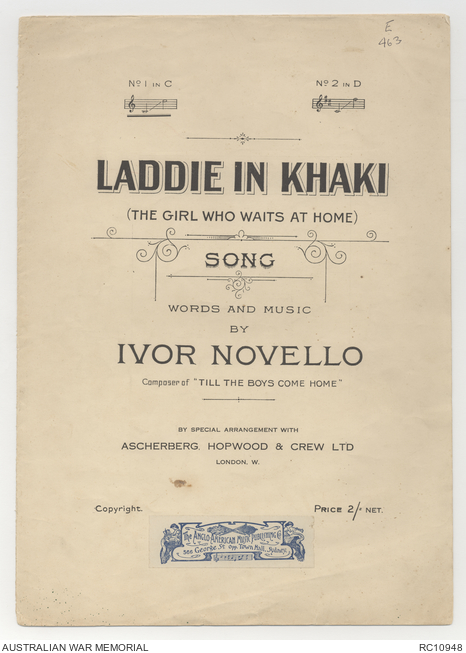| Accession Number | RC10948 |
|---|---|
| Collection number | Sheet Music Collection 463 |
| Collection type | Published Collection |
| Record type | Item |
| Item count | 1 |
| Object type | Sheet Music |
| Maker |
Novello, Ivor |
| Place made | United Kingdom, United Kingdom |
| Date made | 1915 |
| Conflict |
First World War, 1914-1918 |
| Copying Provisions | Copyright restrictions apply. Only personal, non-commercial, research and study use permitted. Permission of copyright holder required for any commercial use and/or reproduction. |
[Sheet music] Laddie in khaki: (The girl who waits at home)







Sheet music for the song titled 'Laddie in Khaki (The Girl Who Always waits at home)' written and composed by Ivor Novello. The lyrics of this song talk about a girl who is waiting for her soldier to come home and assures him that she will be waiting for his return.
This copy was published under special arrangement with the music publishers Ascherberg, Hopwood & Crew and sold for the price of 2/-. Inside the front cover are the complete, typed lyrics for the song. On the back page is a song titled "When the Great Day Comes".
Born as David Ivor Davies, Ivor Novello was the only son of Madame Clara Novello Davies. His mother was a British singer and composer who had settled as a teacher in New York CIty. She was also the conductor of the the Royal Welsh Ladies' Choir and the winner of several choral singing competitions. Novello had begun singing at a very early age. One story reported in the Sydney Morning Herald, indicates he performed 'Hear Ye, Israel' and 'Poor Wandering One', at the age of 6, for the British contralto Clara Butt. Three years later he won a singing scholarship at Magdalen College, Oxford, where he was the first solo boy for five years. His first song, 'Spring of the Year', was performed by the American high soprano Evangeline Florence at Royal Albert Hall, London, when he was 15. Novello was 21 years old when he wrote the melody for 'Keep the home fires burning', which according to Novello, took only 10 minutes to write.
Towards the bottom of this page is a sound recording of this sheet music, or a parody, that was created as part of the Music and the First World War project. More information about this recording, including names of the performers, can be found on the catalogue record for the sound recording. A link to the catalogue record for the sound recording can be found at the bottom of this page, under the heading ‘Related objects’ where it can be identified with the prefix [sound recording].
- Download PDF document of [Sheet music] Laddie in khaki: (The girl who waits at home) (file)
-
Listen to
[Sheet music] Laddie in khaki: (The girl who waits at home)